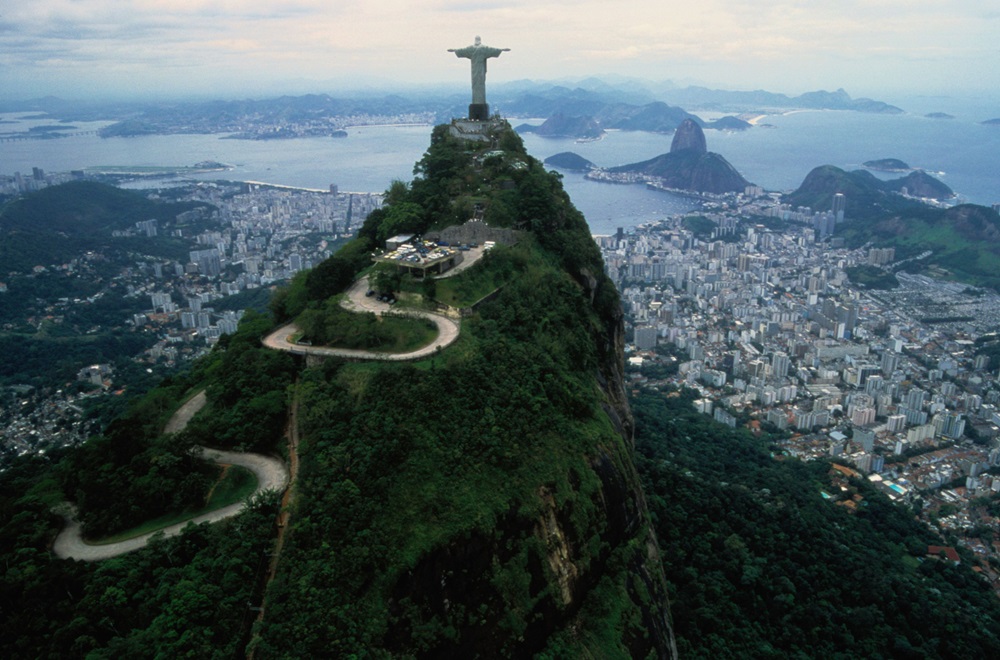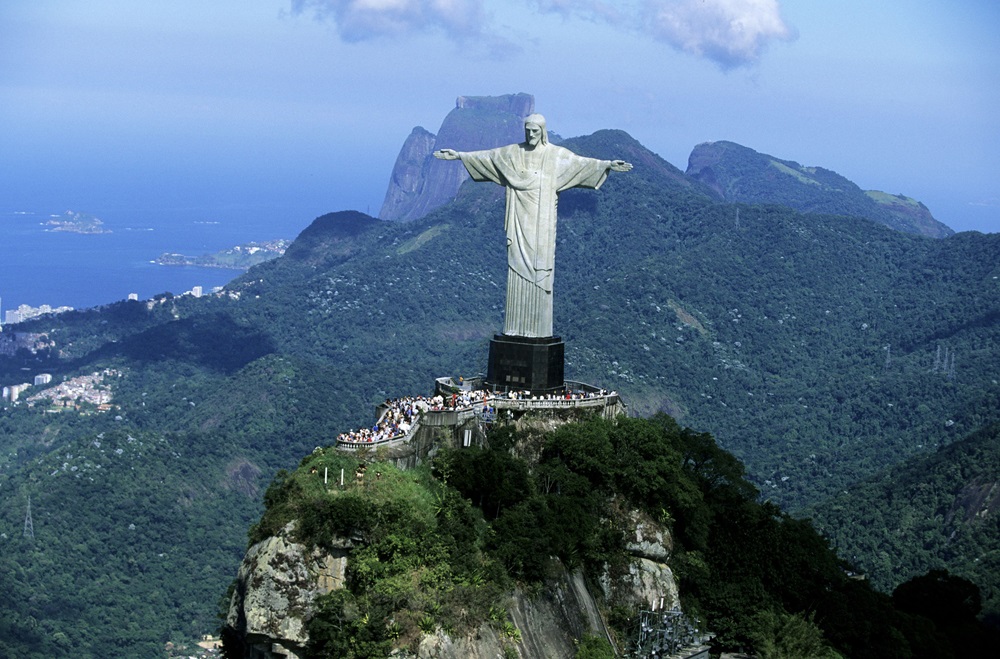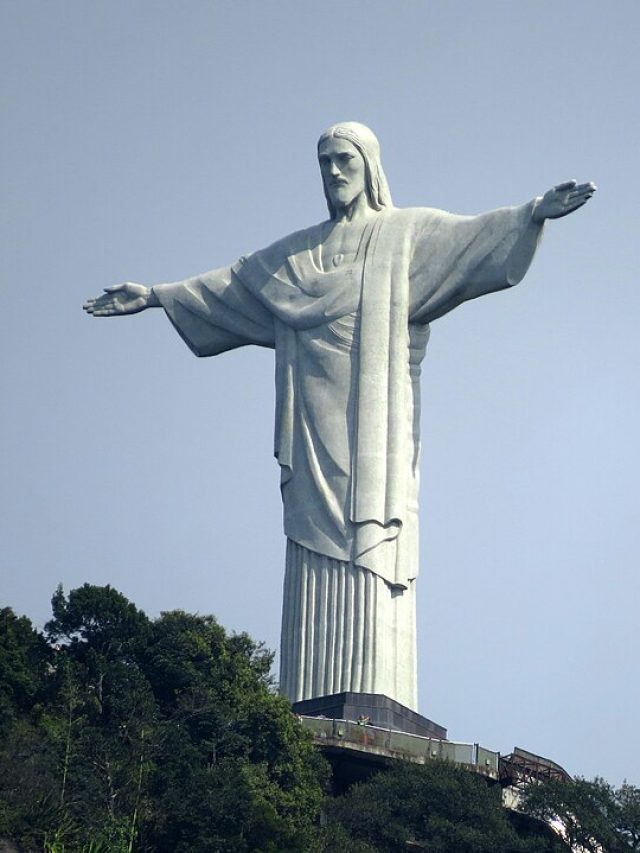Christ the Redeemer Statue
Rio’s Christ the Redeemer Statue exemplifies Art Deco design. Created as a representation of Christianity, the statue is a puppet of Jesus Christ that has gained cultural significance. Paul Landowski and Heitor da Silva Costa designed the sculpture. Costa and Albert Caquot constructed the statue, while Gheorghe Leonida was in charge of the face. Pedro Maria Boss, a Vincentian priest, proposed the initial idea of creating a Christian structure. He saw the monument as an homage to Princess Isabel, the daughter of Emperor Pedro II and regent. But the notion was rejected. Building a statue of Christ bearing the world on a Christian cross was the idea for the second proposal. Nonetheless, the Rio Catholic Circle chose Christ, a peace symbol, with open arms. “Semana do Monumento” (Monument Week) was organised to garner donations and signatures. Ultimately, they raised $250,000, translating to $5 million in 2024.
Soaring magnificently above Mount Corcovado in Rio de Janeiro, Brazil, is the Christ the Redeemer statue, also known as Cristo Redentor. It is a massive work of art and an essential cultural and religious symbol. Built between 1922 and 1931, this enormous statue greets people worldwide with its outstretched arms and height of 98 feet (30 meters). Known as one of the New Seven Wonders of the World, it represents Brazil’s colourful energy and Christianity.
Early Concepts
Father Pedro Maria Boss proposed building a Christian monument atop Mount Corcovado in the 1850s when the idea of creating a massive statue of Jesus in Brazil originated. However, the proposal was abandoned when Brazil declared its independence in 1889, separating the interests of the state and the church15. Following World War I, religious authorities and local community leaders noticed a ‘godlessness’ that they believed was growing in society and felt obliged to revive religious enthusiasm among the Brazilian people15. Their plan to rebuild Rio de Janeiro into a Christian centre included the construction of a notable Catholic monument.
The statue was officially proposed for construction in 1921 by the Roman Catholic Archdiocese of Rio de Janeiro, and it received financial backing from donations made by Brazilian individuals and broad public support. On April 4, 1922, the foundation stone was placed to mark Brazil’s 100th anniversary of independence. Following a competition, the design by Brazilian engineer Heitor da Silva Costa emerged victorious. Intended initially to depict Christ holding a globe and a cross, the final version evolved into the recognisable image with outstretched arms, mainly due to the involvement of painters Carlos Oswald and Paul Landowski.
During the 1926–1931 construction phase, materials were transported to the top of the mountain via a cog-wheel railway, where workers assembled the statue25 using scaffolding. Engineers and artists from Brazil and other countries worked together to add a variety of cultural components to the project.
Religious Symbolism
Christ the Redeemer is a powerful representation of Christianity in Brazil and worldwide. Within Christian teaching, it reflects the love and compassion that Jesus exemplifies and embodies peace, hope, and acceptance. The statue’s embracing embrace of all people, spanning socioeconomic and cultural barriers, is symbolised by its widely opened arms14. For Christians, it serves as a ray of hope and a constant reminder of Christian doctrine’s promise of salvation and redemption.
In addition, the statue serves as a constant reminder of the religion that forms Brazilian society and promotes social cohesion among its populace. Every visit helps people find comfort and rediscover their spirituality, strengthening the church’s significance in Brazilian culture.
Cultural Identity
National pride and Christ the Redeemer have grown intertwined, making Christ the Redeemer an essential part of Brazilian culture. It is regarded as the most recognisable sight in Rio and a global symbol of Brazil. Every year, millions of visitors swarm to the statue, attracted by both its majesty and the spiritual experience it provides. In addition to boosting the economy, this immigration promotes awareness of Brazilian culture and religious history worldwide. The statue is also depicted in several artistic mediums, such as literature and movies, which supports its reputation as a representation of optimism and solidarity in the face of hardship. Brazilian pride and faith are personified by the Christ the Redeemer statue, which captures the country’s distinctive fusion of religious and cultural traditions.
Aesthetic and Architectural Elements

Christ the Redeemer’s architecture, with its streamlined shapes and linear ornamentation, is a striking example of Art Deco architecture4. This aesthetic is reflected in the statue’s general design and impacted numerous buildings built in the early 20th century. The figure’s streamlined shapes, sharp lines, and lack of elaborate details perfectly capture the ideas of Art Deco design, giving it a contemporary yet classic appearance. Every component—such as the reinforced concrete structure and triangle soapstone tiles—highlights the builders’ technical skill. With the engineers considering the effects of wind and lightning, the statue weighs more than 635 metric tonnes. The statue has been kept for years thanks to clever measures that guaranteed its stability and protection.
Christ the Redeemer has a great visual impression. With sweeping views of the city and its coastline, the statue is positioned against Rio’s breathtaking scenery, giving the impression that it is keeping watch over the people below. The statue’s enormous scale inspires awe and reverence from a distance and up close. Light-coloured soapstone is more visible due to its colour selection, which makes it glow in the daylight and look ethereal in the dark. The Latin cross’s design is reflected in Christ’s wide arms, which signify acceptance and heighten the cross’s holy importance. Different perspectives on the statue elicit feelings, such as inspiration or calm. Many people find that visiting the site becomes a personal pilgrimage because of this intriguing architectural feature, which encourages people to pause and think.
Christ the Redeemer has undergone numerous restorations to preserve its visual appeal and structural integrity. In 1980, extensive repairs were carried out in preparation for Pope John Paul II’s visit, and they continued until 2010 to address weather-related damage, including lightning strikes. These initiatives show a dedication to protecting a national treasure and recognising its importance as a spiritual and cultural monument.
Technological developments have improved preservation techniques and the visiting experience. Installing panoramic lifts and escalators in 2002 expedited access to the monument and increased tourism while guaranteeing visitors’ comfort and safety. These activities make the site accessible by fusing ancient spirituality with modern technology. The statue’s significance extends beyond religious bounds in today’s global culture. It is a globally recognised symbol of hope against personal and societal suffering. The picture of Christ with extended arms is a reassuring reminder of faith and resiliency amid challenging times, such as natural disasters or civil unrest.
Conclusion
More than just architectural art, the Christ the Redeemer statue is an essential nexus of Brazilian religion, culture, and artistic expression. The statue’s historical origins show a community attempting to maintain cohesion and direction in the face of change. Millions of people are drawn to it visually, and its deep theological meaning upholds the virtues of love, acceptance, and optimism. Christ the Redeemer is a timeless representation of Brazilian identity that uplifts people from all walks of life and serves as a constant reminder of the strength of faith and community in an ever-changing world.






